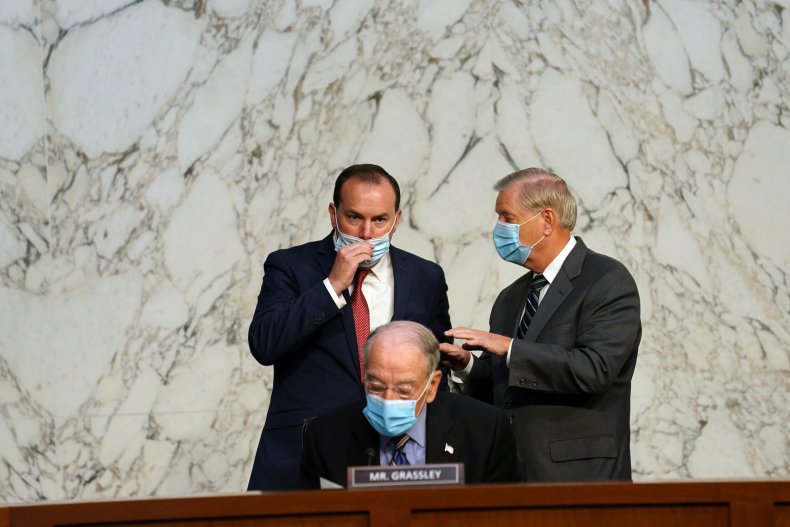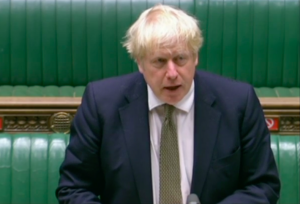Republican Sen. Mike Lee of Utah attended the first day of the confirmation hearings for Supreme Court nominee Amy Coney Barrett on Monday, 10 days after first contracting coronavirus in the immediate wake of attending a super-spreader event at the White House for the judge.
Lee, who was cleared to attend by the U.S. Capitol physician, allows Republicans the ability to obtain the needed quorum to vote later this week to advance Barrett’s nomination out of committee.
Ten days after virus contraction or the onset of symptoms is the recommended isolation period by the Centers for Disease Control and Prevention. Lee wore a mask during most of Monday’s hearing, but he removed it prior to and during his opening remarks. Judiciary Committee Chairman Lindsey Graham (R-S.C.) was maskless for most of the hearing while Sens. Joni Ernst (R-Iowa) and Dianne Feinstein (D-Calif.) did not put theirs on until after several lawmakers spoke.
Lee’s symptoms remained “mild” and treated at home, according to a letter from the senator’s doctor that his office released. His last reported fever was on Thursday, and it was reported that he became symptom-free starting on Sunday. It’s been 12 days since he first developed symptoms. Lee has not said when or if he received a negative test, but the U.S. Capitol physician said one was not required.
“Based upon current CDC guidelines, you have met criteria to end COVID-19 isolation for those with mild to moderate disease,” Dr. Brian Monahan wrote to Lee. “The CDC does not recommend repeat SARS-CoV-2 PCR testing if these criteria are met.”
Questions were raised about whether the confirmation process, which is moving at breakneck pace just weeks before the election, would be delayed after Lee and fellow Judiciary member Thom Tillis (R-N.C.) contracted the disease after a Sept. 26 event that led to dozens of lawmakers, White House officials and other prominent Washington figures testing positive.
Days later, President Donald Trump also tested positive, though it’s unclear how he contracted the disease.
The White House conducts rapid tests for visitors, but such tests are known to produce false negatives. The event featured no social distancing and little mask usage. Lee was among those seen closely mingling with others without donning a face mask. Tillis wore a mask.
The confirmation hearings will occur over the next three days, followed by a vote on Thursday to advance Barrett’s nomination to the full Senate.
“We hope it won’t be too dramatic,” White House chief of staff Mark Meadows briefly told a Capitol Hill reporter prior to the hearing.
Senators may choose to participate virtually, though most on Monday attended in-person. The process is taking place in a large room in the Senate Hart Office Building to allow for social distancing. Still, some Democrats have expressed concerns and pressed for greater precautions.
Sens. Patrick Leahy (D-Vt.), Kamala Harris (D-Calf.) and Cory Booker (D-N.J.) urged Graham—a confidant to the president who has refused to take a coronavirus test—to implement testing procedures for the hearings. Graham has refused. More broadly, House Speaker Nancy Pelosi (D-Calif.) and Senate Majority Leader Mitch McConnell (R-Ky.) have rebuffed their members’ pleas for a Capitol-wide testing regimen.
“We should not be holding this hearing when it’s plainly unsafe to do so,” Leahy, who is 80 years old, said via webcam. “Two members of this committee [are] just now remerging from quarantine after testing positive for COVID, and when other members have declined to get tested and the chairman has refused to implement a daily testing regimen to keep members, staff and Judge Barrett and her family safe.”
“Trump can’t even keep the White House safe,” said Sen. Sheldon Whitehouse (D-R.I.), who attended in-person.
Sen. Ted Cruz (R-Texas) also participated virtually.
The number of new daily coronavirus cases in the U.S. is on the rise once again with more than 50,000 per day, the most since August. As of Sunday, more than seven million cases have been reported in the U.S. this year, and more than 214,000 Americans have died from the virus.



















